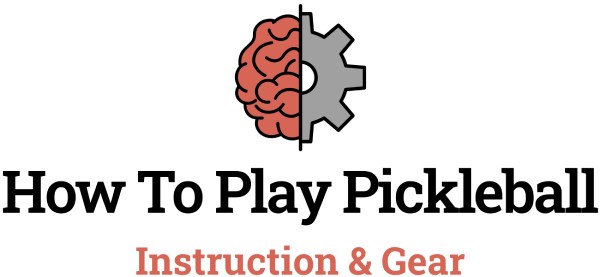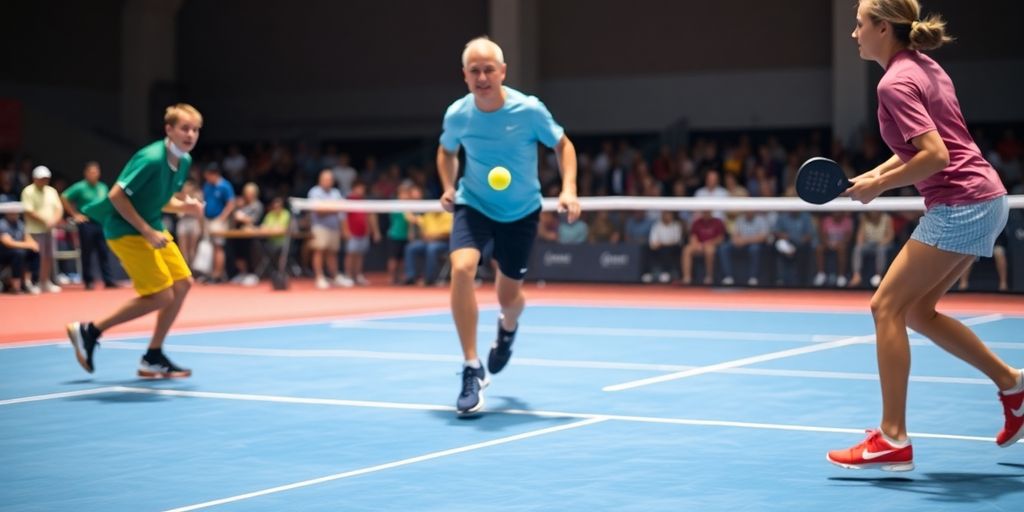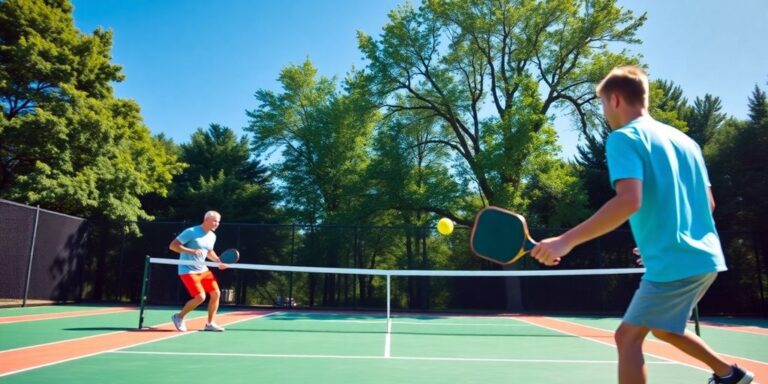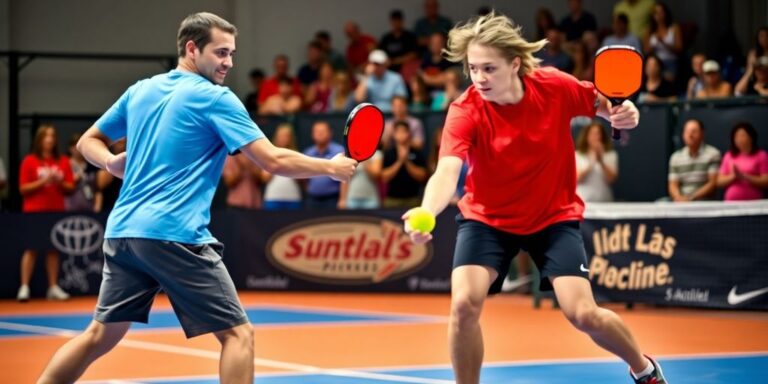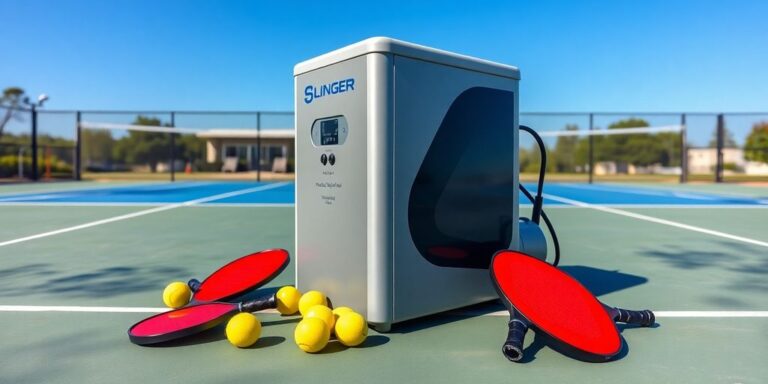Pickleball’s bounce rule might sound like a small detail, but it’s a game-changer on the court. This rule is all about ensuring fair play and adding a layer of strategy to every match. Whether you’re serving or returning, mastering the bounce rule can be the difference between winning and losing. Let’s break it down and see how you can use it to your advantage.
Key Takeaways
- The bounce rule requires the ball to bounce once on each side before volleys are allowed.
- It helps slow down the game, giving players time to get into position.
- Many players misunderstand the rule, thinking they can volley right away.
- The rule is crucial in both singles and doubles play, impacting strategies.
- Practicing with the bounce rule in mind can improve your overall game.
Understanding the Pickleball Bounce Rule
The Origins of the Bounce Rule
The origins of the bounce rule in pickleball are a bit foggy, but the rule itself has become a bedrock of the game. Pickleball, born in 1965 thanks to Joe Pritchard and Bill Bell, combined elements of tennis, badminton, and ping-pong. The bounce rule might have been inspired by early ideas of fairness, ensuring that both sides have a fair chance to play. Though its exact beginnings are unclear, this rule has grown to be a fundamental part of the game, promoting longer rallies and engaging gameplay.
Why the Bounce Rule Matters
The bounce rule is crucial because it levels the playing field. By requiring the ball to bounce once on each side before players can volley, it removes the immediate advantage of smashing the ball right after the serve. This rule encourages strategic play, allowing players to develop tactics and think a step ahead. It also ensures that games aren’t just about power but about skill and strategy. This rule keeps the game exciting and fair for everyone involved.
Common Misconceptions About the Rule
There are a few common misconceptions about the bounce rule, often leading to confusion, especially among newcomers. Some players mistakenly believe that the ball can be volleyed immediately after the serve, which is not the case. Another myth is that the bounce rule only applies during the serve, but it actually affects the first two hits of each rally. Understanding that both the serving and receiving teams must let the ball bounce once before volleys can begin is key to mastering the game. Clearing up these misunderstandings helps players avoid unnecessary faults and enjoy smoother gameplay.
Mastering the Two-Bounce Rule in Pickleball
The First Bounce: Serving Strategies
Getting the serve right is where it all starts. In pickleball, the serve must land beyond the kitchen line and inside the diagonal service area. This is where you set the tone. You want to aim deep but not too deep. A deep serve can push your opponent back, giving you more time to prepare for their return. But, if you serve too deep, you risk a fault. So, it’s a balance. Practicing different serve depths can help you find that sweet spot. Remember, the first bounce is key to maintaining control of the rally.
The Second Bounce: Return Techniques
After the initial serve and its bounce, the returning team has the ball in their court, literally. The goal is to let the ball bounce once before hitting it back. This gives you a moment to assess your opponent’s position and plan your next move. A well-placed return can set you up for a strong position in the rally. For instance, aiming for your opponent’s weaker side or placing the ball at their feet can disrupt their rhythm. The second bounce is where you start to dictate the pace.
Avoiding Common Mistakes
Even seasoned players can trip up with the two-bounce rule. Here are a few pitfalls to watch out for:
- Rushing the Serve: Take your time to set up properly. A rushed serve often leads to faults.
- Ignoring Court Position: After serving or returning, make sure you’re not caught out of position. Always be ready for the next shot.
- Overhitting Returns: It’s tempting to go for power, but control is more important. Focus on placing the ball strategically rather than just hitting it hard.
Mastering the two-bounce rule isn’t just about following a regulation; it’s about leveraging it to enhance your game. By understanding the dynamics of each bounce, you can turn this rule into an advantage, making your play more strategic and less predictable.
Strategic Positioning for the Bounce Rule
Positioning for Singles Play
In singles play, understanding where to stand can make all the difference. Start by positioning yourself a few feet behind the baseline. This gives you ample time to react to deep serves and ensures you’re not caught off guard by the ball’s bounce. After returning the serve, make your way to the net. This move not only puts pressure on your opponent but also sets you up for quicker volleys.
- Stand a few feet behind the baseline to handle deep serves.
- Move towards the net after your return to gain an advantage.
- Maintain a balanced stance to quickly shift directions.
Positioning for Doubles Play
Doubles play introduces another layer of complexity. Here, communication with your partner is key. Both players on the serving team should start behind the baseline. This setup accounts for the two-bounce rule, ensuring neither player is caught off guard. For the receiving team, one player can position near the non-volley zone, ready to take advantage of any short returns.
- Begin behind the baseline to manage the two-bounce rule.
- Communicate constantly with your partner to avoid confusion.
- Position one player near the non-volley zone for strategic volleys.
Adjusting to Opponent’s Play Style
Every opponent is different, and adapting to their style is crucial. If they favor deep shots, be prepared to hang back a bit more. Conversely, if they prefer short, angled plays, you’ll need to be quick on your feet and ready to move forward. Anticipating your opponent’s next move is half the battle.
The bounce rule isn’t just a regulation; it’s a strategic tool. By mastering your positioning, you can turn the rule to your advantage, dictating the pace and flow of the game. Remember, it’s not just about where you stand, but how you move.
The Impact of the Bounce Rule on Game Dynamics
How the Rule Levels the Playing Field
The two-bounce rule in pickleball is a game-changer, literally. By requiring the ball to bounce once on each side after a serve, this rule ensures that both teams have an equal opportunity to engage with the ball. This levels the playing field by eliminating the serve-and-volley advantage, which can often lead to quick and decisive points. Without this rule, games might end too quickly, leaving little room for strategic play. By enforcing the two-bounce rule, rallies become longer and more engaging, allowing for a fairer competition.
Influence on Rally Length and Strategy
The two-bounce rule significantly influences how rallies unfold. Longer rallies mean players need to think a few steps ahead, considering not just their next shot but how it sets up their position for subsequent plays. This naturally leads to more strategic, thoughtful gameplay. Players can’t just rely on power or speed; they must be tactical in their approach. The rule encourages players to use a variety of shots, from dinks to drives, to outmaneuver their opponents.
Adapting to the Rule for Competitive Play
Adapting to the two-bounce rule is crucial for players who want to compete at higher levels. It requires a shift in mindset from aggressive play to a more balanced approach that values patience and precision. Players must practice positioning and footwork to capitalize on the opportunities the rule presents. Here are a few tips for adapting to the rule:
- Practice patience: Wait for the right moment to attack, rather than rushing to volley.
- Improve footwork: Position yourself well to handle the second bounce effectively.
- Develop shot variety: Use different types of shots to keep opponents guessing and off-balance.
The two-bounce rule not only makes pickleball more accessible to beginners but also adds a layer of complexity for seasoned players. Embracing this rule can transform a player’s approach to the game, making it more about strategy and skill than sheer power.
Training Tips for Perfecting the Bounce Rule

Drills to Improve Bounce Rule Compliance
Improving your pickleball game starts with understanding the bounce rule. It’s not just about knowing it but feeling it in play. Start with simple drills. For instance, practice letting the ball bounce twice before hitting it back. This helps you get used to waiting, which can be hard at first. Set up cones or markers to create zones where you can practice hitting the ball after it bounces. This way, you can focus on timing and placement without worrying about the broader game.
Practicing with Partners
Playing with a partner can make a huge difference. You can take turns serving and returning, focusing on the bounce rule. Try to communicate clearly with your partner about when to let the ball bounce. This not only helps with the rule but also builds teamwork. Use this time to work on positioning and footwork, as these are crucial in handling the bounce rule effectively. Practicing together can make it easier to anticipate each other’s moves, which is key in doubles play.
Using Technology to Enhance Skills
Technology can be a game-changer for improving your skills. Use apps and devices that track your shots and bounces. These tools can provide feedback on your timing and accuracy. Video analysis is another great option; record your games and watch them to see how well you’re adhering to the bounce rule. This self-review can highlight areas for improvement. Additionally, consider using a ball machine to practice consistently without needing a partner.
Mastering the bounce rule isn’t just about following the rules; it’s about integrating them into your natural playstyle. With consistent practice and the right tools, you can turn this rule into a strategic advantage on the court.
By focusing on these aspects, you’ll not only improve your understanding of the bounce rule but also enhance your overall gameplay. Remember, practice makes perfect, and these tips are designed to help you get there.
Advanced Techniques for the Bounce Rule

Incorporating the Rule into Advanced Play
When you step up your game, the bounce rule becomes more than just a basic guideline—it’s a tool for strategic advantage. Mastering the bounce rule requires understanding its nuances and using them to your benefit. For instance, when you’re serving, aim to place the ball in a way that forces your opponent to make a difficult return. This not only sets you up for a successful second bounce but also keeps your opponent on their toes.
Analyzing Professional Matches
Watching professional matches is a fantastic way to see the bounce rule in action. Notice how pros position themselves and anticipate the ball’s movement. They often use the bounce to control the pace of the game, switching from defensive to offensive play seamlessly. Take notes on their footwork and positioning, and try to incorporate these tactics into your own play.
Developing a Personal Strategy
Creating a personal strategy around the bounce rule can significantly enhance your gameplay. Start by identifying your strengths and weaknesses in relation to the rule. Do you excel at making the first bounce challenging for your opponent? Or are you better at capitalizing on the second bounce? Tailor your practice sessions to focus on these areas, and consider keeping a journal to track your progress and refine your strategy over time.
"The bounce rule isn’t just about compliance; it’s about using it as a strategic tool to outsmart your opponent and gain the upper hand in the game."
By focusing on these advanced techniques, you can transform the bounce rule from a simple regulation into a key component of your winning strategy.
The Bounce Rule and Fair Play in Pickleball
The bounce rule in pickleball is like the great equalizer, ensuring everyone gets a fair shot at the game. By requiring the ball to bounce once on each side before volleys, the rule helps maintain an even playing field. This means no player can hog the advantage right off the serve, making the game more about skill and less about brute force.
The Role of Referees and Officials
Referees and officials are the unsung heroes in pickleball, keeping the game fair and square. They make sure everyone sticks to the rules, especially the bounce rule, which can sometimes be a bit tricky. Their keen eyes catch those sneaky faults and ensure the game flows smoothly. Without them, disputes could easily get out of hand, and the spirit of fair competition might suffer.
Handling Disputes Over the Rule
Disagreements over the bounce rule can pop up, especially in heated matches. It’s key to handle these disputes calmly and respectfully. Here’s a quick guide to resolving them:
- Pause the game: Stop play to address the issue immediately.
- Consult the referee: If there’s an official present, let them make the call.
- Discuss with opponents: If no ref is around, talk it out with your opponents.
Remember, pickleball is all about fun and sportsmanship. Keeping a cool head during disputes not only resolves issues faster but also upholds the friendly spirit of the game.
The Future of the Bounce Rule in Pickleball
Potential Changes to the Rule
The 2025 pickleball rule changes have sparked curiosity about how the bounce rule might evolve. While some players advocate for keeping it as is, others suggest tweaks to make the game faster. Any changes could significantly alter gameplay dynamics, affecting strategies and player positioning. The ongoing debate centers around whether the rule should adapt to new playing styles or stay rooted in tradition.
Community Opinions on the Rule
Opinions in the pickleball community are as varied as the players themselves. Some love the rule for adding a layer of strategy, while others find it restrictive. A few players believe that modifying the rule could make the game more exciting, but there is also a strong contingent that values the balance it brings to the sport. Community discussions often highlight the rule’s role in leveling the playing field, especially for newcomers.
The Rule’s Role in Pickleball’s Growth
The bounce rule is more than just a regulation; it’s a defining feature of pickleball. As the sport continues to grow, the rule helps maintain its unique identity. It encourages longer rallies and strategic play, making the game accessible and engaging for all skill levels. As pickleball gains popularity, understanding and mastering the bounce rule becomes crucial for anyone looking to improve their game. The rule not only influences how the game is played but also how it is perceived by new players and fans alike.
The bounce rule in pickleball isn’t just about gameplay—it’s a cornerstone of the sport’s identity. Its future will shape how the game evolves and continues to capture the interest of players worldwide.
As we look ahead, the bounce rule in pickleball is set to evolve, shaping how the game is played. Understanding these changes is crucial for players and fans alike. Stay informed and enhance your skills by visiting our website for the latest updates and expert advice!
Wrapping It Up: Mastering the Bounce
So, there you have it! The pickleball bounce rule isn’t just a quirky regulation; it’s a game-changer. By mastering this rule, you’re not only playing by the book but also setting yourself up for some seriously strategic gameplay. Remember, it’s all about patience and positioning. Letting the ball bounce twice might seem like a small thing, but it can really slow down your opponent and give you the upper hand. Keep practicing, stay aware of your court position, and soon enough, you’ll be using the bounce rule to your advantage without even thinking about it. Happy playing, and may your rallies be long and your shots precise!
Frequently Asked Questions
What is the Pickleball Bounce Rule?
The Pickleball Bounce Rule means the ball must bounce once on each side before players can volley it. This helps keep the game fair and exciting.
Why is the Bounce Rule important in Pickleball?
The Bounce Rule makes sure that both teams have a fair chance to play. It stops teams from gaining an unfair advantage by volleying too early.
How does the Two-Bounce Rule work?
In the Two-Bounce Rule, after the serve, the ball must bounce once on the receiving side and once on the serving side before any team can hit it in the air.
What happens if I ignore the Bounce Rule?
Ignoring the Bounce Rule results in a fault, and the rally ends. This means the other team gets the point.
Can I hit the ball before it bounces in Pickleball?
Yes, but only after the ball has bounced once on each side of the net at the start of the rally. After that, you can volley the ball.
Does the Bounce Rule apply to both singles and doubles?
Yes, the Bounce Rule applies to both singles and doubles games in Pickleball. It ensures fair play in any match.
